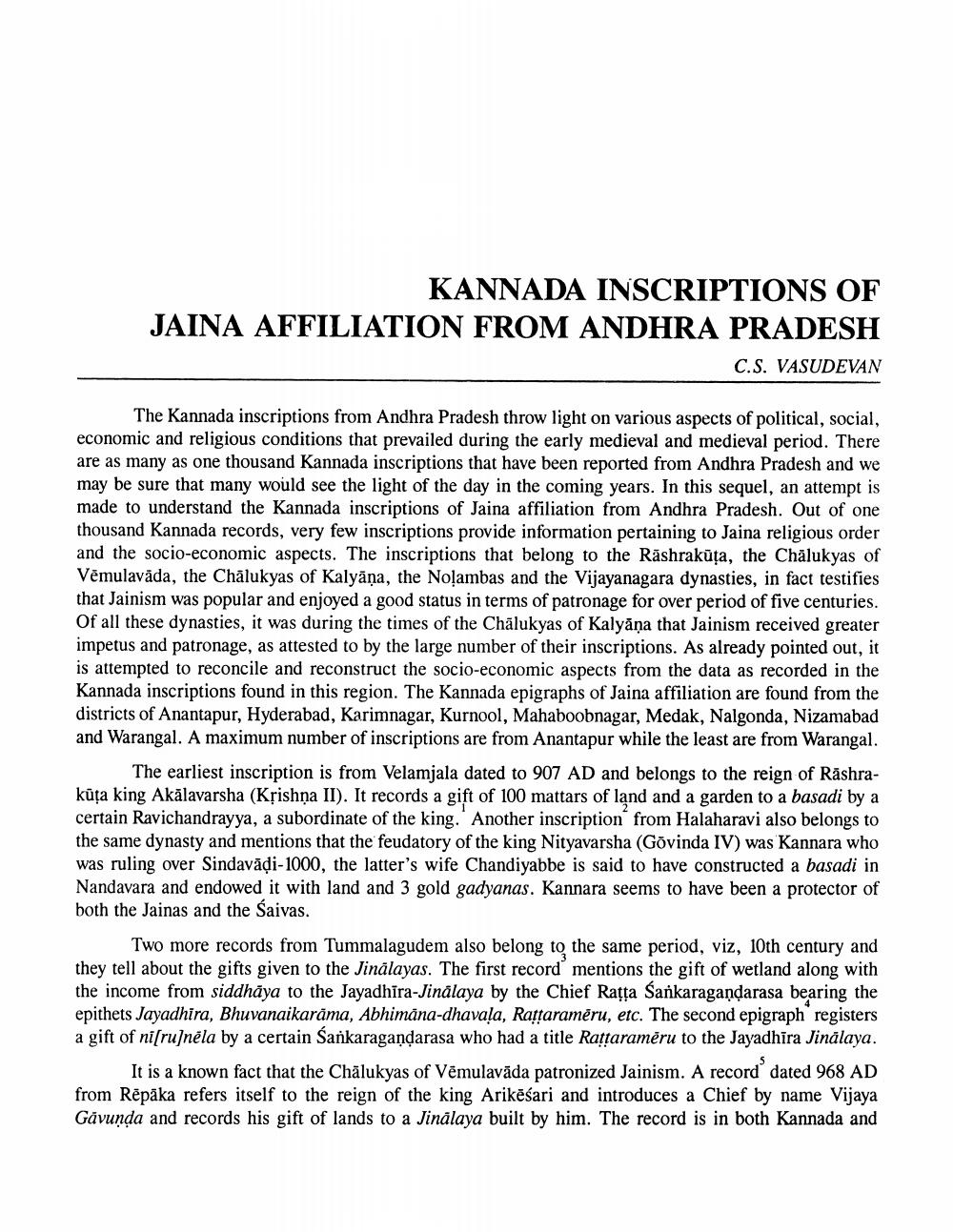________________
KANNADA INSCRIPTIONS OF JAINA AFFILIATION FROM ANDHRA PRADESH
C.S. VASUDEVAN
The Kannada inscriptions from Andhra Pradesh throw light on various aspects of political, social, economic and religious conditions that prevailed during the early medieval and medieval period. There are as many as one thousand Kannada inscriptions that have been reported from Andhra Pradesh and we may be sure that many would see the light of the day in the coming years. In this sequel, an attempt is made to understand the Kannada inscriptions of Jaina affiliation from Andhra Pradesh. Out of one thousand Kannada records, very few inscriptions provide information pertaining to Jaina religious order and the socio-economic aspects. The inscriptions that belong to the Räshraküța, the Chalukyas of Vēmulavāda, the Chālukyas of Kalyāņa, the Noļambas and the Vijayanagara dynasties, in fact testifies that Jainism was popular and enjoyed a good status in terms of patronage for over period of five centuries. Of all these dynasties, it was during the times of the Chālukyas of Kalyana that Jainism received greater impetus and patronage, as attested to by the large number of their inscriptions. As already pointed out, it is attempted to reconcile and reconstruct the socio-economic aspects from the data as recorded in the Kannada inscriptions found in this region. The Kannada epigraphs of Jaina affiliation are found from the districts of Anantapur, Hyderabad, Karimnagar, Kurnool, Mahaboobnagar, Medak, Nalgonda, Nizamabad and Warangal. A maximum number of inscriptions are from Anantapur while the least are from Warangal.
The earliest inscription is from Velamjala dated to 907 AD and belongs to the reign of Rāshrakūța king Akalavarsha (Kțishņa II). It records a gift of 100 mattars of land and a garden to a basadi by a certain Ravichandrayya, a subordinate of the king. Another inscription from Halaharavi also belongs to the same dynasty and mentions that the feudatory of the king Nityavarsha (Govinda IV) was Kannara who was ruling over Sindavādi-1000, the latter's wife Chandiyabbe is said to have constructed a basadi in Nandavara and endowed it with land and 3 gold gadyanas. Kannara seems to have been a protector of both the Jainas and the Saivas.
Two more records from Tummalagudem also belong to the same period, viz, 10th century and they tell about the gifts given to the Jinalayas. The first record mentions the gift of wetland along with the income from siddhāya to the Jayadhira-Jinalaya by the Chief Rațța Sankaragandarasa bearing the epithets Jayadhira, Bhuvanaikarāma, Abhimana-dhavala, Rattaramēru, etc. The second epigraph registers a gift of ni[ru]něla by a certain Sankaragandarasa who had a title Rattaramēru to the Jayadhīra Jinalaya.
It is a known fact that the Chalukyas of Vēmulavāda patronized Jainism. A record dated 968 AD from Rēpāka refers itself to the reign of the king Arikēśari and introduces a Chief by name Vijaya Gāvunda and records his gift of lands to a Jinalaya built by him. The record is in both Kannada and




